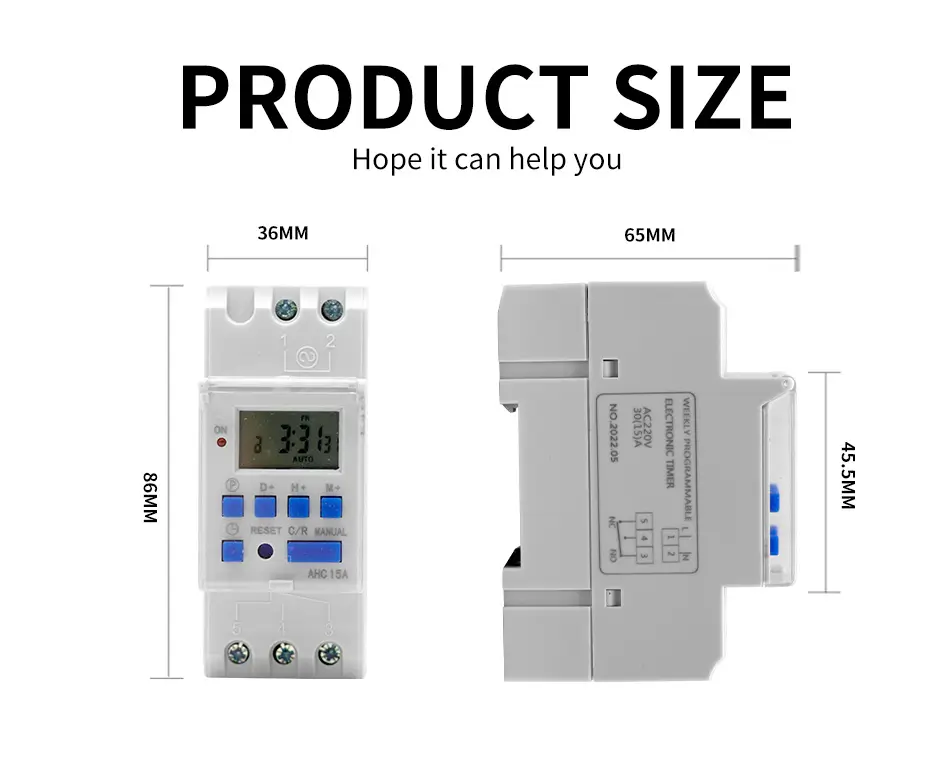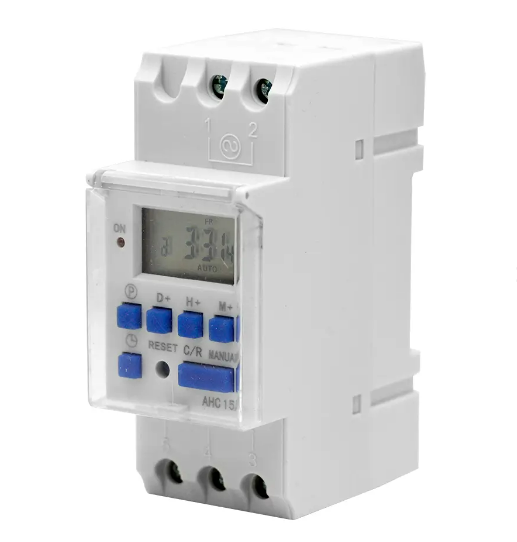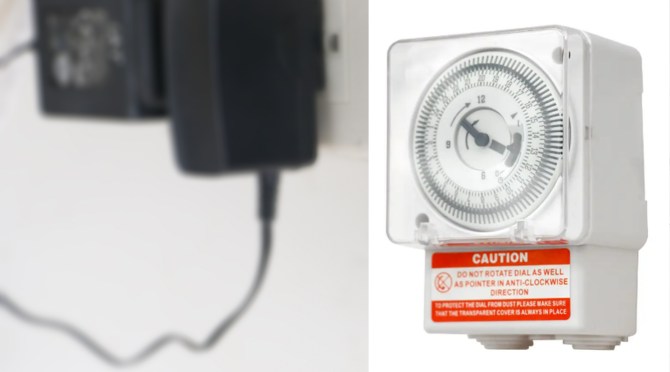In a technology-driven world, efficiently managing electrical appliances is not only a convenience, it’s a necessity. Time switches are key components in modern automation systems, allowing for precise and easy control of the operation of lights, appliances, and industrial equipment.
By allowing users to set specific times for devices to turn on or off, time switches improve convenience significantly reduce energy consumption, and extend the life of various electronic devices. This article will delve into the definition of time switches their types and their various applications in different fields.
What is a Timer Switch?

A time switch is an electrical device that automatically controls an appliance by setting a specific time for it to turn on or off. For example, it can turn lights, fans, and other appliances on or off according to a preset schedule.
This switch can be divided into mechanical and digital types, and advanced models also support random timing, countdown, and remote control functions to improve energy efficiency and convenience.
Timer Switch Function
The main function of a timer switch is to automatically turn appliances on and off at preset times. Not only does it save energy by ensuring that appliances are only turned on when needed, it also enhances security by simulating occupancy within a building.
In addition, it eliminates the need to manually control each appliance, making it ideal for everyday tasks such as controlling lighting, heating systems, and garden watering systems.
How does a Timer Switch work?
A time switch works by activating or deactivating a connected electrical device according to a preset schedule. Here’s a breakdown of how it generally works:
1. Setting the timer
The user programs the timer by selecting specific times for the device to turn on and off. This can be done with a dial setting on a mechanical timer or a digital interface on an electronic timer where the user can enter a precise time and date.
2. Internal clock
The time switch has an internal clock mechanism that keeps track of time. In mechanical models, this may involve a rotating dial that aligns with the marked time to trigger the switch action. Digital models use an electronic clock for more accurate timekeeping.
3. Trigger mechanism
Once the current time matches the preset time, the timer activates the trigger mechanism. In a mechanical timer, this involves the physical movement of gears and switches. In a digital timer, it involves an electronic signal that changes the state of the switch.
4. Power control
When activated, the time switch connects or disconnects the circuit to the connected device. This either opens or closes the circuit, allowing current to flow to the device and turn it on or stops the current to turn it off.
5. Repeat
The process repeats according to the programmed schedule, cycling on and off a number of times specified by the user. Some timers also allow for manual overrides, letting users manually turn connected devices on or off without affecting the programmed schedule.
Setting a Timer Switch can effectively manage energy consumption, and also increase convenience and enhance safety by controlling lights and appliances in predictable or random patterns.
Types of Timer Switches

There are several types of time switches, each suited to specific applications and user preferences. Here are a few of the most common types:
1. Mechanical time switches
Mechanical timer switches use a simple dial to set the operating cycle. The user rotates the dial to mark the start and end times, usually 24 hours. They are simple and reliable, and are commonly used in everyday household applications such as lighting and small appliances.
2. Digital time switches
Digital timer switches offer a user-friendly digital interface that allows for precise scheduling. They allow for multiple on/off cycles, customizable daily or weekly schedules, and sometimes special settings for holidays. These are ideal for more complex setups in homes and businesses that require detailed control.
3. Programmable time switches
Programmable timer switches allow for detailed control, with the ability to set different schedules for weekdays and weekends. They are particularly well suited for managing energy use in systems such as HVAC in residential and commercial buildings, optimizing operations based on occupancy and usage patterns.
4. Astronomical time switches
Astronomical timer switches adjust their operation based on local sunrise and sunset times, making them ideal for outdoor lighting and security systems. They use geographic coordinates to align with daylight changes, ensuring that outdoor lights only operate in the dark.
5. Countdown time switches
Countdown timer switches allow users to set a timer that automatically turns off after a specified duration. These are ideal for controlling fans and lights in the bathroom or kitchen, ensuring they only run when needed to save energy and prevent unnecessary usage.
6. Random time switches
Random timer switches operate devices at unpredictable times within defined intervals, making a building appear occupied. This feature is particularly useful for security purposes, deterring potential intruders by simulating activity in an empty house or building.
Each type has its own characteristics in each application, and understanding these types of timer switches will give you some ideas about whether you are looking to buy or compare.
Applications of Timer Switches
Time switches have a wide range of applications in various fields, improving convenience, energy efficiency, and safety. Here are some of the main applications:
1. Home Automation time switches
Home automation time switches to control lighting, heating, and air conditioning to ensure that these systems operate only when needed. They help maintain a comfortable environment and reduce energy consumption by scheduling devices such as thermostats and lights to turn off when unoccupied.
2. Outdoor lighting time switches
Outdoor lighting time switches can be used to manage outdoor lighting systems such as garden lights, street lights, and security lights. Time switches can be set to turn these lights on at sunset, turn them off at sunrise, or only operate at specific times, ensuring safety while minimizing energy waste.
3. Industrial equipment time switches
Time switches control the operation of machinery, ensuring that equipment only operates during necessary production hours. This helps reduce wear and tear on machinery and conserve energy in large-scale manufacturing processes.
4. Commercial building time switches
Offices and other commercial buildings use time switches to regulate HVAC systems, lighting, and security systems, optimizing energy use based on the building’s typical occupancy schedule.
5. Aquarium and garden time switches
Time switches are used in aquariums to regulate lighting and filtration systems and simulate the natural light cycle of aquatic life. In gardens, they can control irrigation systems to ensure watering occurs at the most efficient times to keep plants healthy and conserve water.
6. Holiday decoration timers
They are often used to managing holiday decorations, including Christmas lights, ensuring that decorations are only lit at the best viewing times to enhance the holiday spirit while controlling electricity costs.
7. Security system timers
Timers enhance security by randomly turning lights and other devices in a building on and off to simulate occupancy, deterring potential break-ins when occupants are away for extended periods.
Overall, timers can effectively reduce human intervention, save energy, and enhance security in a variety of environments.
Conclusion
In summary, a time switch is a versatile device that can effectively enhance safety and energy efficiency. From simple mechanical designs to complex digital and astronomical models, time switches meet a wide range of needs and preferences.
In addition, their use in commercial environments and industrial operations helps maintain precise control of equipment and reduce operating costs. By integrating time switches into our systems, we can significantly improve electricity efficiency, strengthen safety measures, and enjoy a higher level of convenience in our daily lives.
At the same time, you can find more electrical equipment in Moreday. In addition to time switches, there are many solar accessories and new energy EV charging to meet the needs of your application.
FAQ
1. What are the benefits of using a timer switch?
Timer switches offer energy savings, increased safety, convenience, and the ability to precisely control appliances. They help reduce energy waste, ensure that lights and appliances are only on when needed, and can also deter potential intruders by keeping rooms well-lit when unoccupied.
2. What to consider when choosing a timer switch?
When choosing a timer switch, consider the following:
Load Type: Make sure the switch can handle the specific type of load (resistive, capacitive, inductive) for the device you plan to control.
Mounting Type: Decide on a plug-in or in-wall mount, depending on your ability and willingness to handle electrical wiring.
Programming Features: Look for features like astronomical or photocell functions if your application requires them.
Manual Override Options: Check to see if the switch allows manual control without disrupting the preset program, which is useful for unexpected needs.
3. Can a timer switch be used with any type of light or appliance?
No, not all-timer switches are compatible with every type of appliance or light fixture. Some are designed specifically for resistive loads like incandescent lamps, while others can handle capacitive or inductive loads like motors or fluorescent lamps.
Related reading: Solar transfer switch: The complete guide


